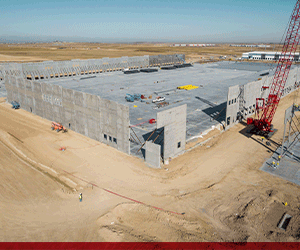Data Centers, once a niche investment and inflexible asset for global enterprises, are now a cornerstone of the information economy, and $100 billion has poured into the asset class over the past decade, according to Cushman & Wakefield’s Data Center Market Comparison.
While the top 10 markets — Northern Virginia, Silicon Valley, Dallas, Chicago, New York/New Jersey, Singapore, Amsterdam, Los Angeles, Seattle and London — maintain supremacy, emerging markets such as Atlanta, Denver, Dublin, Las Vegas, Phoenix, Portland, Salt Lake City, Sydney and Vancouver offer compelling alternatives.
“Denver, one of several secondary data center markets that has seen an increase in activity recently, due mainly to its extensive network infrastructure and low risk of natural disasters,” said Dave Fanning, executive managing director and leader of Cushman & Wakefield’s Data Center Advisory Group. “We anticipate Denver will continue to gain a higher profile in the data center market as IT infrastructure becomes more distributed and emerging technologies are adopted by enterprise businesses.”
As the hometown of many key data center operators Denver also has lower overall land costs than other large markets in the Western U.S.
Cushman & Wakefield’s study evaluated 1,162 data centers across 38 global markets, with each data center scored across 12 weighted criteria. In consideration of each market, the highest weight was given to cloud availability, fiber connectivity and market size; mid-weight considerations were development pipeline, government incentives, market vacancy, political stability and sustainability; and low-weight considerations included environmental risk, land prices, power costs and taxes.
Although the study’s top three markets had considerably higher scores than fourth place, the next 12 markets were separated by a final score of less than 10 percent. This close placement represents a new shift toward key secondary areas fast becoming primary markets around the globe.
“The speed with which the industry is shifting makes the creation of a data center strategy a complex and daunting task,” said Dave Fanning. “Enterprises must determine what to do with their on-premises facility, which workloads to move to the cloud and how to implement a hybrid IT strategy. Developers and operators require a parcel with robust fiber and access to power as well as a thorough grasp of the permitting process and all risk factors. Investors must be able to assess the long-term potential of a data center to hold its value and how easily it can be upgraded. All involved require access to capital and a clear understanding of objectives.”
Large sites have sold recently in emerging U.S. markets such as Portland, Phoenix, and Atlanta, with these areas potentially offering significant savings over locating in California or Northern Virginia. Additional markets in Asia-Pacific – especially Sydney, Tokyo, Hong Kong, Beijing and Shanghai – also are expecting considerable growth in the next two to three years, with demand for greater connectivity and need for modernization of older assets required. The top 15 global markets will thus remain extremely competitive for the foreseeable future.
“The top markets provide the greatest number of options to the greatest number of perspectives,” said Kevin Imboden, director of Research for Cushman & Wakefield’s Data Center Advisory Group. “While one size sometimes does fit all, for certain specializations it’s important to review and understand the factors most important to the specific requirement and aim accordingly. Combined with those markets that have been overlooked and underutilized, there is great potential for niche development and secondary markets across the globe.”









